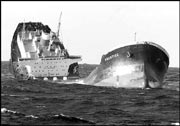Six weeks ago, Puget Sound’s nightmare came true again, off the coast of Europe. The Prestige, a single-hulled, 26-year-old tanker carrying more than 60,000 tons of heavy fuel oil, split and sank off Spanish Galicia. For Europeans still recovering from the Erika wreck three years ago, this was one spill too many. The European Union’s commissioners called for an immediate ban on single-hulled tankers carrying crude and other heavy oils. France, Spain, and Portugal, the countries in the spill’s path, leaped ahead and banned single-hullers more than 15 years old. Asian and Greek shipping companies, which operate many older tankers, howled. French and Spanish warships responded by escorting two persistent rustbuckets out to sea.
What if such a rule were enforced here? That would be a dream come true for those who worry about the marine environment. If you fret more about the price of gas, it might be a nightmare: Nearly half the tankers plying Washington’s waters could dock here no more. According to data collected by the state Department of Ecology, only nine of 41 U.S.-flagged tankers working here in 2002 would pass Europe’s age test; the average age of those 41 was 19.5 years. The 77 foreign-flagged tankers sailing here tended to be younger, just 11.4 years on average. Fifty-four of them were less than 16 years old. But of those, another 21 were more than 10 years old—unlikely, therefore, to have the double hulls that shipyards started building in earnest in the 1990s, after the United States and European Union ordered single hulls phased out by 2015 in the wake of the 1989 Exxon Valdez spill in Alaska’s Prince William Sound.
YOU CAN THANK American shipyard costs and industrial/labor protection for the fact that American tankers tend to be so much older than foreign ones. Shipbuilding is cheaper in other countries, so ships tend to get built there. But the Jones Act, which Congress passed to preserve the domestic shipping industry, lets only U.S.-built ships sail between U.S. ports—i.e., between Alaska’s pipeline terminus at Valdez and Washington’s refineries. So the oil companies keep older, American-built tankers going as long as possible on domestic routes.
Shippers play down the risks of aging tankers. “Using age as a single deciding factor is not appropriate,” says Frank Holmes, the Western States Petroleum Association’s Northwest manager. He argues that the prevention plans and training required of U.S. operators compensate for age and the fact of single hulls.
George Clark, vice president of Pennsylvania-based Keystone Shipping, stands by older ships in word and deed; his company operates what is by far the oldest tanker to work Washington waters in recent years, the 44-year-old, 39,374-ton Fredericksburg, scheduled to be phased out in 2005. Clark notes that the Fredericksburg, whose fore-section was replaced (still with a single hull) in 1983, was one of the first ships to be recognized by the state for following “best available practices.” He compares it to a just-won’t-die Datsun or Volvo: “A well-maintained older car operates as well as, or maybe better than, a new car with all the additional computer equipment that can go wrong. It’s the same as an older ship.”
BUT PARTS WEAR OUT and things go wrong, even on the best old cars. Likewise tankers; the Fredericksburg has a safety rap sheet a mile long. The Coast Guard cited it for two deficiencies—improper boiler maintenance and damaged hull plates from an encounter with a Houston dock—in 2002 and investigated 26 minor accidents and oil discharges in the preceding nine years. That tally is much longer than the Coast Guard sheet on every younger tanker I examined. But Clark says it is “not unusual,” and is so long because Keystone, unlike many other shippers, does not self-insure, so each little claim it makes goes on its record.
Age isn’t the whole story, but it’s “very definitely a factor,” says retired University of Washington engineering professor Ed Wenk, who first worked on tanker safety while serving in the Johnson administration and wrote an influential post-Exxon Valdez report urging double hulls. Wenk recounts how tankers descend along the industry food chain as they age, from high-end operators to the bottom feeders. The first owner “will maintain one till it no longer seems cost-effective, then sell it to a second owner who knows it’s unsafe and never intends to maintain it well, who sells it when it’s perceived as a liability.” The third owner buys it very cheap and runs it into the ground—squeezing out “two or three transits,” then beaching it in Bangladesh, where “ship breakers” tear it down for scrap.
Elongated and heavy with cargo, tankers, like jetliners, undergo severe stresses, strains, and metal fatigue. Their hulls can, as a San Francisco Chronicle reporter put it after interviewing the chair of UC Berkeley’s ocean-engineering program, “develop hundreds of small cracks that are hard to detect but can open like a zipper if the ship hits heavy weather.” Or split like a melon, as the Prestige did. With their double hulls, new gear, and lower wear, says Dodge Kenyon, a marine inspector in the state Department of Ecology’s Puget Sound Field Office, “newer ships leave you more room for error.”
Nevertheless, says Kenyon, “the people taking care of that thing—on the bridge, in the engine room, on shore—matter more.” They can botch or bypass the most up-to-date technology, if they don’t understand it or don’t want to use it. Fast operators especially like to divert the pipes that collect oily sludge from their tanks and engine rooms, which can cost tens of thousands of dollars for proper in-disposal, dump it at sea, and lie in their logs. Two months ago Kenyon spotted oil left over from ocean dumping dribbling into Tacoma harbor from the tanker Kaede, which is registered to a Panamanian firm and operated by a Singaporean one. Just before Christmas, in a signal case, these companies agreed to pay a federal fine of $750,000, undertake “comprehensive environmental compliance,” and serve probation; the Kaede‘s chief engineer, who also pleaded guilty, awaits sentencing.
KENYON DOESN’T DOUBT that other operators likewise dump oil, fake their logs, and skate through often-cursory inspections. These shady shippers register with “flag of convenience” nations and quasi-nations with minimal to nonexistent inspection capabilities. Wenk recalls one flag state that required just two things from owners wishing to register ships: a check and a phone call. Even “some of the oil majors with newer ships will use flags of convenience,” says Kenyon. “It saves them hundreds of thousands of dollars on maintenance.”
And so the Prestige-shocked Europeans also want to exclude flag-of-convenience tankers, defying “freedom of the seas” tradition. If they do, notes Kenyon, dodgy operators “are going to be pushed out of that market, and we’re going to see them here.” If they’re not already here: Last year, 35 tankers flying the favorite flags of convenience—Panama, Liberia, and the Bahamas—sailed to Washington. So did others nominally based in Malta, Myanmar, landlocked Luxembourg, the Marshall Islands, the Isle of Man, the Netherlands Antilles, and that famous maritime center, the “French Antarctic Lands.”
BUT INDUSTRY DEFENDERS note that even ships registered under such flags can get professional scrutiny from the private agencies they (and U.S.-flagged carriers) go to for certifications. Keystone Shipping, for example, proudly submits all its ships to the 140-year-old American Bureau of Shipping (ABS), one of the largest and best-regarded inspection and classification services.
Whoops. ABS inspected the Prestige only last May, following comprehensive inspections and extensive repairs a year earlier. It’s now investigating the sinking off Spain and, doubtless, re-examining its own procedures.
But there is some accountability in the system. Says spokesman Dan Cummings of British Petroleum, a leading Alaska-Washington oil shipper: “BP inspected the Prestige in 2000, found it totally unacceptable, and didn’t use it.” Fortunately, says Keystone’s George Clark, the Jones Act keeps “suspiciously owned, suspiciously operated ships like the Prestige from trading in U.S. waters.”
Whoops again. According to the San Francisco Chronicle, the Prestige logged “at least 33 visits” to U.S. Gulf and Atlantic ports between 1989 and 1999. It doesn’t seem to have reached Puget Sound.










